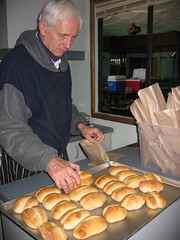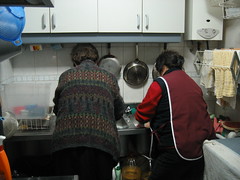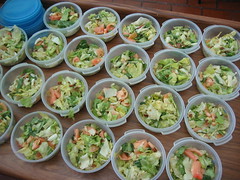Helpin' a brother out
20 August 2007
12:55 PM

At least twice a week I find myself working in a pretty remarkable place: the kitchen. Specifically, the parish kitchen. That’s ground zero for Br. Donald Kutchenmeister’s meals-on-wheels-style program, known here as Comida Sobre Ruedas. Four days a week, Monday through Thursday, Donald and a group of volunteers prepare lunch for 45 people. The days are busy—we cook all morning, pack up the food, send it out to be delivered, begin preparations for the next day, and then wash all the dishes when the delivery crew returns—but they’re invariably the high points of my workweek in Chile.
A typical day begins at 9:00am as three or four volunteers scramble around the tiny kitchen to prepare the daily menu. Recipes come from sources as commonplace as Betty Crocker and The Joy of Cooking, but also from unusual tomes like The Best Iquiqueña Recipes of All Time (Iquique is a city in the far north of Chile). Donald prepares all the menus for the year during the summer, trying to balance the offerings of any given day—if the main dish is pasta, the side dish isn’t potatoes—but also to coordinate the food served on successive days. If participants eat chicken one afternoon, he tries to avoid serving a similar dish again until he has rotated through other options.
I often make the salad, on occasion the main dish, but rarely the soup. Quantities are appropriate for fifty people, but sometimes they seem ludicrous. I have peeled and chopped 25 lbs. of potatoes, juiced 30 lemons, and sliced 40 carrots. Last Thursday I had to shred five heads of lettuce, boil and chop 10 eggs, slice 15 tomatoes, juice lemons, and prepare a liter of dressing. My dad told me he’s excited to have me cook for the family when I go home, but I think cooking for five will be a let down; there’s something very satisfying about combining huge vats of ingredients. If I finish ahead of time, I lend a hand with any other tasks or tackle the mountain of dishes that always piles up quickly.
Once the foods are ready, we begin to package everything to send it out, which is its own major operation. We put individual salads into empty margarine tubs. Soup goes into thermoses, the main dish and side dish go into insulated tubs, and fresh bread goes from the oven to brown paper bags. Everything gets put into numbered boxes for delivery. Thermos #17 and tub #17 go into box #17 which goes to Lucia on Tobalaba street. By 12:15pm all the tubs and boxes are packed and we make the hand-off to Paula and Jaime, the couple that delivers the food. Until the dishes come back, we’re on low alert. We eat lunch ourselves and talk.
The Comida Sobre Ruedas program is just three years old. After retiring as director of the Holy Cross foster home, Donald traveled to the U.S. to study at the Culinary and Hospitality Institute of Chicago. He got straight A’s, but he qualifies that saying, “You had to be pretty lazy not to get an A in the classes.” Upon returning to Chile, Donald found that the Congregation was no longer holding the fundraising dinners he had hoped to prepare with his new culinary training. While he figured out what to do next, he did a practicum at a bakery and a kitchen that served two restaurants, a steakhouse and a place that served typical Chilean cuisine.

Eventually Donald decided to start his program to help people in the St. Roque parish. He had two groups of people in mind: those who didn’t have the resources to cook nutritious meals—some current participants receive pensions of $80 a month—or couldn’t readily cook for themselves. During the slow summer months, he reads through cookbooks and assembles the year’s daily menus. He currently cycles through about 70 different menus, each with an entrée, salad, soup, side dish, bread, and dessert. He makes some changes on a day-to-day basis—recipes are “just suggestions,” he insists—but the basic format is planned far in advance. When the program launched in 2005, there were just 16 people who received food; now there are 45.
I’ve also learned a tremendous amount working in Donald’s kitchen. I know the Spanish names for just about any spice you can imagine: jenjibre is ginger, tomillo is thyme, and eneldo is dill. I can tell you the best way to wash leeks (slice the base in half and hold the end of one half under running water while you thumb through the sheets). One afternoon Br. Donald showed me a better way to chop with a knife. “They taught me this method at chef school,” he said, “but I never did it until it until I got to Chile. In the restaurant where I did my practicum one of the chefs, who hadn’t even graduated from high school, told me I was doing it all wrong.” I dice, chop, and mince, although the Chilean women I work with make me look like a tortoise. Best of all, I don’t live in perpetual fear of messing up. That’s saying something for someone who, as recently as last year, was truly uninspired in all things culinary.
More than any technical instruction, however, I’ve also learned much from the spirit of the program. Many times I think we are satisfied with mediocrity in charity. People are lucky to be getting anything at all, so they shouldn’t be concerned with quality. It’s an unspoken, perhaps subconscious attitude, but it’s essentially the converse of “don’t look a gift horse in the mouth.” The bar in Donald’s kitchen is set much higher: the attitude there is that the people we serve deserve the best we can offer. We use good-quality ingredients, instead of the cheapest we can find. Meals are not only nutritious, but good enough to serve in a restaurant.

Sometimes I wonder if the people receiving the food notice the attention to detail. I realized the effort was worthwhile when I heard about one recipient who commented remarked about his lunch, “I feel like I am eating at the Hilton Hotel every day.” Many of the people I have met and worked with in the last two years don’t go out to eat. One time when I invited a friend to lunch she was so impressed by the restaurant—a typical place by my standards—that she talked about it for weeks afterward. I have visited some of the people Donald’s program serves, and the food they receive is just about the only thing in their houses that might be mistaken for hotel quality. Food is a rich part of the human experience, and it affirms the dignity of the poor to offer them the chance to partake in it.
Of course, the cost matters and it’s reasonable. Each meal costs, on average, about $3. I recently read that the New York school district was offering meals to students during the summer at roughly the same cost. For Chileans lunch is the largest meal of the day, on par with the American dinner. With that in mind our program delivers fresh bread, soup, salad, a main dish, and a side dish. The lunch we send is large enough that many people save the soup to eat as their dinner. Until recently we also sent dessert, but it has been eliminated to cut costs. Unfortunately Donald is having a difficult time finding funding to finish this year and continue in 2008. I’m hoping to put together a small fundraising campaign during September to make that more likely. If that’s something that interests you, keep your wallet nearby and stay tuned.

Typically our lunchtime conversations and digressions are cut short by the delivery crew. Before long, Paula and Jaime return with yesterday’s dishes. Washing and drying the dishes is a prolonged process because we do it by hand. Once I counted 340 individual items as I washed, the sum of all the lids, caps, thermoses, and so forth. Sunday through Wednesday we also have to prepare for the following day, which means chopping and cutting all the fruits and vegetables from the next daily menu. Many hand make light work (but too many cooks spoil the broth—contradiction?), and during the week 16 different volunteers help in the kitchen. Depending on exactly how many hands are on hand and how much work the next day entails, we finish between 4:00pm and 6:00pm. Then the kitchen closes, I go home, and the next day it’s someone else’s turn to help the brother out.


Comments